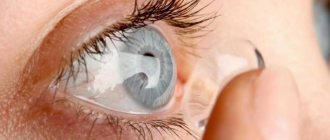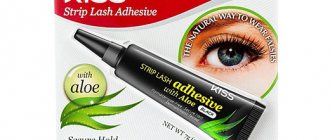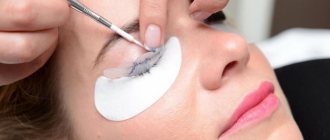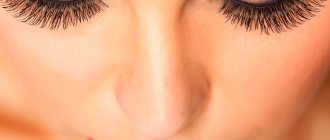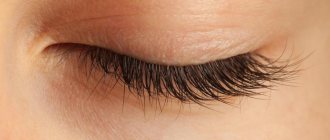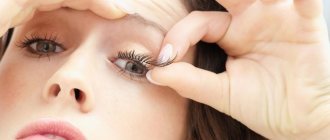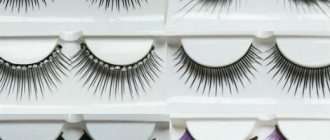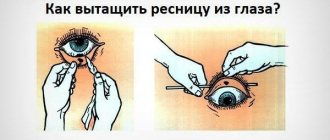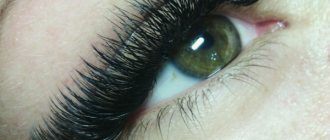Features of the procedure
The main task of an eyelash extension artist is to carefully glue artificial hairs to the very base of natural (native) eyelashes. Such hairs are usually attached to a special glue with resin.
For extensions, two main methods are used:
- eyelash method (each hair is processed separately, i.e. 1 artificial eyelash is attached to each natural eyelash);
- beam method (a beam consisting of 3-4 artificial hairs is immediately glued to the eyelash base).
There are also differences in the volume of extension:
- full (artificial eyelashes fill the entire space along the eyelid);
- incomplete (natural and artificial hairs alternate, or the space is filled only in the corners of the eyelids);
- 2D (2 foreign eyelashes are attached to one native eyelash);
- 3D (3 artificial eyelashes are attached to one natural eyelash);
- Hollywood look (5 artificial hairs are attached to one natural hair, usually used exclusively for photo shoots or theatrical performances).
Stages
Eyelash extensions are carried out in several stages.
Important! Some steps may differ depending on the extension method, but basically the procedure is carried out according to a single scheme.
- Preparation of native eyelashes (makeup removal is carried out).
- Isolation of lower hairs (lower eyelashes are protected with special patches).
- Degreasing the hairs (this is an important stage on which the duration and quality of eyelash wear depends).
- Using a primer (helps clean the eyelash more deeply and open the cuticle).
- Preparing a box with artificial hairs (you can use a special tablet on which it is convenient to arrange eyelashes by size, curve, thickness, etc.).
- Mixing the glue (remember to change it every 15-30 minutes).
- Using a neutralizing spray (change the disc with the spray with each change of a drop of glue).
- Treatment with an activator (necessary if the technician suddenly becomes uncomfortable working with glue).
- Hair extensions (duration and technique will depend on the extension method and client requests).
- Application of a fixative preparation (the fixative is applied to the root zone).
- Combing (gives the hairs the desired direction).
- Removing a patch.
The extension process is shown in the video:
Materials used
For extensions, specialists can use hairs from a variety of materials. The most popular types:
- silk (the hairs have a glossy shine, the thickness of one eyelash is 0.15–0.25 mm);
- mink (have a structure similar to natural human hair, thickness is 0.07–0.12 mm);
- sable (thicker eyelashes, but elastic and mobile, used for incomplete extensions);
- columns (the maximum thickness of one eyelash is 0.15 mm, holds curl well and adds volume).
Important! In addition to artificial eyelashes, the master uses specialized glue for extensions, a degreaser, a disinfectant for tools, eye make-up remover, an activator, a primer and a neutralizer.
Tools
The most important tool for an eyelash extension artist is tweezers . It exists in several variations:
- straight (needed to fix eyelashes);
- L-shaped (used for eyelash extensions);
- L-shaped (suitable for 3D extensions);
- hook (used to glue and hold bundles);
- Vetus ST 17 (suitable for extensions in the corners of the eyes).
In addition to tweezers, the master will need:
- special tape;
- patches;
- brushes for combing hair;
- consumables (wipes, cotton pads, masks, etc.);
- microbrushes (needed for correction and hair removal).
Myth three: limits your lifestyle
After the extension, you will have to give up something. For example, you should not get your eyelashes wet or cry for the first two hours while the glue dries. For the first 48 hours after visiting the master, you cannot go to the bathhouse or sauna.
Tears, high temperatures, oily and greasy textures are undesirable. Hairs straighten or come unglued. What does this mean in practice?
- Do not apply greasy cream to your eyelids. Regular eye cream is not applied to this area, but along its very edge. And this is enough for the skin. Avoid cosmetic oils or micellar water - they dissolve the glue. If your skin is prone to greasiness, your eyelashes will last less. Mascara extensions deteriorate faster.
This is interesting: Eyelash tinting is a procedure worth trying for yourself
Let's make a special mention about touches and temperatures:
- You shouldn't rub your eyes, pluck your hairs or tug at them - they will last less. The same will happen if you like to sleep with your face in your pillow. You can swim and swim. Contact with water seems uncomfortable due to the fact that the eyelash area has become larger. The resistance force of water is higher, it becomes noticeable. Blink your eyes, the unpleasant sensations will pass faster. High temperatures are evil for polymers. To make the curls last longer, place a towel or napkin soaked in cool water over your eyes. You can sunbathe and visit the solarium no later than a day before the procedure! During this time, the natural balance of the skin will even out, it will not be overly dry.
The lifestyle doesn't change much. But if you want to wear eyelashes longer, then adjusting it is not difficult.
Advantages and disadvantages
Eyelash extensions certainly cannot be called an absolutely safe procedure. It has both pros and cons.
Advantages:
- allows you to quickly get the desired result;
- does not require additional application of makeup (in the rain, in the heat, in the pool, and in the sauna - you will always look great even without mascara);
- the ability to correct the shape of the eyes (you can make the eyes more round or, conversely, elongated by filling certain areas with hairs);
- saves a lot of time (again, does not require applying makeup, does not require correction during the day).
Flaws:
- artificial hairs can stick together or break off;
- Eye irritation may occur;
- natural hairs may begin to thin and fall off;
- correction is required every month;
- it is difficult to find a really good master who will do everything according to the rules;
- serious self-discipline will be required (no rubbing of the eyes, no use of oily cosmetic products);
- there is a high probability of developing allergic reactions.
The pros and cons of eyelash extensions are discussed in the video:
How to protect yourself?
To extend the life of artificial eyelashes, you should avoid makeup and greasy creams. Visiting the sauna, pool or beach is also not recommended.
You should carefully choose a specialist and always check the brands and certificates of the glue used. Equipment inspection is mandatory. To avoid deterioration of the condition of your own eyelashes, 1 day before the session you should avoid makeup and eyelid creams. Cosmetologists recommend taking a break of 5-7 days between repeated procedures. After removing eyelashes, it is recommended to make lotions from a solution of retinol, tocopherol, and aloe juice. To strengthen the hairs, it is recommended to wash the eyes with herbal decoctions, which include chamomile, St. John's wort, calendula, and sea buckthorn. If an allergic reaction occurs, the component should be replaced.
Is it harmful to the eyes?
Yes and no. The main damage to the eyes can be caused by low-quality or expired eyelash glue . High-quality adhesive compositions used in expensive professional salons cannot harm the eyes, eyelashes or skin (the only exception is situations in which the client has an individual intolerance to the composition).
Important! You shouldn't skimp on your health. Contact only licensed salons and experienced professionals who have been successfully carrying out the procedure for several years.
Possible side effects
If the procedure was performed incorrectly or low-quality materials were used, the following negative symptoms may appear:
- redness of the skin of the eyelids;
- itching and burning in the eyes;
- gluing eyelashes;
- increased lacrimation;
- swelling of the eyelids;
- loss of natural eyelashes;
- acute pain in the eyeball;
- temporary blurred vision.
This is interesting: How to glue rhinestones onto eyelash extensions 2019
Return to contents
When can a procedure really cause complications?
There are several circumstances in which eyelash extensions are contraindicated due to the high risk of complications:
- Increased eye sensitivity . People prone to allergic reactions, frequent conjunctivitis, or who have undergone relatively recent eye surgery are not allowed to undergo cosmetic procedures. Glue vapors will lead to inflammation in the eyes.
- Dry eyelid skin . If the client has too dry eyelids, has dermatitis, eczema or other negative manifestations, then he will not be allowed to undergo the procedure. This is not only dangerous for the skin, but can also be dangerous for artificial hairs, which simply fall out under the influence of fatty medicinal creams.
- Wearing contact lenses . When removing and putting on contact lenses, a person in any case has a physical impact on the eyelashes, and this is contraindicated for them.
- Brittle and thin natural eyelashes . The large weight of artificial hairs, numerous twists, the influence of glue - all this will lead to the fact that the already thin natural eyelashes will become even thinner and simply fall out.
Why are eyelash extensions harmful?
Negative consequences after visiting a cosmetic center are reflected in various areas, but specialists usually do not warn about this.
Be careful, after visiting the salon there may be consequences of eyelash extensions that are harmful to the client:
- Allergic reaction to consumables used by the cosmetologist. This is usually followed by irritation of the sensitive surface of the eye, the appearance of itching, and similar factors. Eyelash extensions are harmful to your eyelashes in this case.
- Premature removal of work. This usually happens when the hairs on the eyelid are poorly secured or when a low-quality adhesive is used.
- Inaccurate visual result of the work. Often girls receive a style that looks unnatural and inappropriate on a girl’s face.
- Damage to the health of natural eyelashes. When repeating the technique on hairs many times, it becomes harmful to preserving the structure of the natural hair layer of the eye.
Before performing the technology, consider the harmful effects of eyelash extensions in order to prevent side effects after the service is provided.
Is it possible to constantly increase?
If you do not get carried away with the procedure (i.e. do not regularly extend eyelashes for 2-3 years in a row), then the harm will be minimal. However, no one is immune from deformation, loss and thinning of natural eyelashes.
How often can I do it?
The possible frequency of eyelash extensions depends on the duration of eyelash wear, the method and scheme of extensions.
Most experts agree that the minimum break between procedures should be approximately 200 days (the natural renewal cycle of natural eyelashes).
You can, of course, do the procedure every 90 days, like most clients, but in this case the risk of thinning natural hairs increases significantly.
Myth two: natural and synthetic materials
Extensions have become accessible even to sensitive people, because artists use hypoallergenic materials.
The names of polymer fibers - silk, mink, sable - are used to indicate the effect:
- silk is thin, mink is medium and close to ordinary human ones, and sable is an imitation of thick and long eyelashes.
- Firstly, because it is a potential allergen. Secondly, natural fibers are more popular with bacteria and infections.
Living conditions on polymer hairs are not comfortable for microorganisms.
Black eyelash glue contains dyes, ask to replace it with a colorless one if you are afraid of allergies.
What to do if natural hairs are damaged?
If you have seriously damaged your natural eyelashes after extensions, then it is better to take a break and put your natural hairs in order using several procedures:
- Remove makeup from your face and eyes before going to bed every day. Use only mild cleansers and do not rub your eyes with your hands or a towel.
- Use natural oils to restore natural hairs. Regular castor oil works best (simply soak an eyebrow brush in the oil and gently “color” your eyelashes with it before going to bed).
- Brush your eyelashes regularly with a dry, clean brush.
The nuances of caring for your natural eyelashes after removing extensions are described in the video:
It is impossible to say unequivocally whether the eyelash extension procedure harms the eyes, natural hairs or skin of the eyelids. It all depends on the characteristics of the client’s body, the experience of the master, the quality of materials and tools and many other factors. So it is best to consult with an experienced specialist before carrying out the procedure and choose the best option for eyelash lengthening.
Causes of negative symptoms
It is important to consider that it is prohibited to carry out procedures during the active phase of development of cataracts, glaucoma or conjunctivitis. If there are purulent formations in the eyes, you should definitely notify the technician to avoid infection of the equipment. Ignoring contraindications may cause deterioration in the condition of the visual organs. Poor quality materials also lead to inflammatory processes and acute allergic reactions.
If during the procedure any infection was introduced into the organs of vision, the person’s eyelids may turn red.
Redness of the skin of the eyelids and blurred vision may be a consequence of infection. The equipment must undergo a sterilization procedure before the client arrives. And also constantly wearing eyelash extensions, if your own are weakened and have a thin structure, can lead to their loss and even greater thinning.
Why is it important to know when to stop?
If you notice a couple of eyelashes falling out, then there is nothing to worry about. Natural eyelash loss is, as stated above, normal and common. We all lose eyelashes, but we usually don't notice it. The norm is considered to be the loss of five hairs per day. It’s bad if eyelashes begin to fall out more intensely.
This can happen when using eyelash extensions. It is very important that the master accurately selects the thickness and length of artificial hairs to match the parameters of the client’s own eyelashes. We all have different thicknesses of hair, and the same applies to eyelashes. If you glue excessively heavy or long artificial eyelashes onto thin and weak natural eyelashes, then your own eyelashes simply will not cope with the task of lifting and supporting foreign ones, and will begin to break off and become thinner. It's even worse if the hair follicle is damaged.
Whatever lash makers say about the complete safety of eyelash extensions for your own hairs, this is disingenuous: even with ideal extensions, your eyelashes suffer, and therefore they must rest from time to time, wearing glued-on hairs without a break is not good for eyelashes and can even have a detrimental effect . You can increase the length of eyelashes no more than 3 mm beyond your original ones. Then it will not be dangerous for natural hairs.
Myth four: about eye diseases
It is possible to get an infection during extensions if the technician works with violations of Sanitary Regulations and Regulations. If you see this, leave immediately. Professionals recognize risks and responsibilities, therefore they do not allow violations and understand “picky” clients.
If, after a procedure carried out with violations, you have to undergo treatment, then you can contact a lawyer to file a claim and claim.
If your eyes are sensitive or you wear contact lenses, the risks increase.
Manipulations on already infected eyelids pose a great danger.
The discomfort of the disease and the unusual sensations after the procedure with a lash maker can be confused. Conjunctivitis, blepharitis, stye, edema are complicated after extensions also because girls do not immediately notice their symptoms.
Foreign fibers on the inflamed eyelid become a painful burden. Artificial eyelashes make it difficult for an ophthalmologist to examine them.
The extension itself does not entail eye diseases; this relates to the conditions of the procedure. Any eye disease for eyelids with hair extensions is a complete torment, although without artificial eyelashes it would only be a little easier.
Folk remedies for relieving redness and infection in the eyes
Lotions made from black or green tea and medicinal herbs will help relieve redness and the development of infection.
Bags of black or green tea without any additives can be applied to the eyes 3-4 times a day the next day after the procedure. The temperature should be room temperature or a little cooler. Then you can repeat a couple of times a week.
The following herbs are used:
- calendula;
- pharmaceutical camomile;
- thyme (savory);
- sage.
The herbal decoction is prepared according to the instructions and used after filtering and cooling to room temperature. Herbs can be used individually or mixed with several ingredients. Cotton pads soaked in the decoction are applied to the eyes and left for 20-30 minutes.
